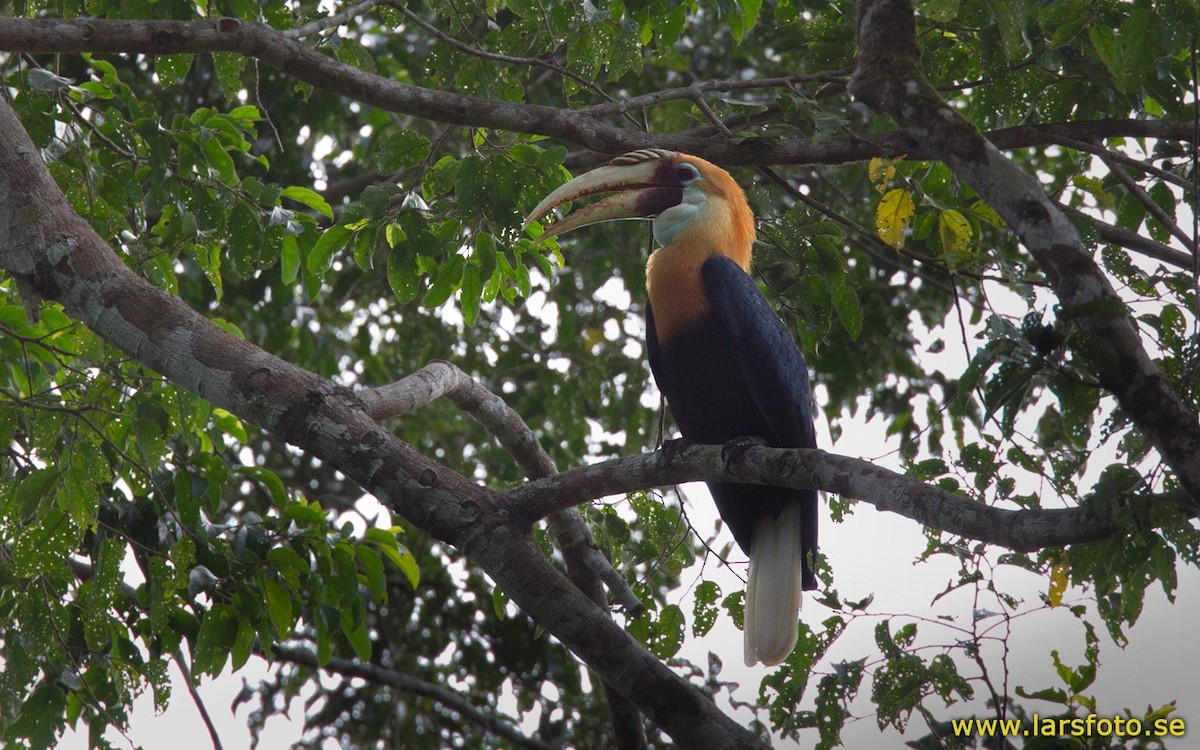Blyth's Hornbill
A species of Hornbill, Also known as Julang Papua Scientific name : Rhyticeros plicatus Genus : Hornbill
Blyth's Hornbill, A species of Hornbill
Also known as:
Julang Papua
Botanical name: Rhyticeros plicatus
Genus: Hornbill
Content
Description General Info
 Photo By Lars Petersson
Photo By Lars Petersson Description
Up to 91 cm (36 in) in length, the adult male has mainly black plumage with a golden or orange-buff head, white throat and a white tail. Its irises are reddish brown, and the eye is surrounded by naked pale blue skin. The female is a smaller, mainly black bird with a white throat and tail. Both sexes have a very large horn-coloured bill and casque. Young birds of both sexes resemble the male. Adults have up to eight folds on the pale casque, depending on age, while young birds have none. In flight the sound of its wings is loud and distinctive, a rushing noise that has been compared to the sound of steam escaping from a steam locomotive. It has a range of far-reaching, guttural grunting and laughing calls. 
Size
85 cm
Nest Placement
Cavity
Feeding Habits
Blyth's Hornbill predominantly consumes fruit, such as figs and various tree fruits. Occasionally, it ingests animal matter like beach crabs and bee honeycombs. It forages alone or in flocks and exhibits communal roosting, often departing in groups.
Habitat
The blyth's Hornbill predominantly inhabits evergreen primary and secondary forests, with a presence also in deciduous riverine woodlands and swamp-forests. These environments are characterized by a lush, perennial canopy that supports the diverse dietary and nesting requirements of the species. The blyth's Hornbill's range includes broader regions of tropical lowland rainforests across Oceania, where these habitat conditions are prevalent.
Dite type
Frugivorous
General Info
Feeding Habits
Bird food type

Fruit
Distribution Area
The Papuan hornbill occurs throughout lowland forests, from sea level up to 1,200–1,500 m ASL, in the Moluccas, New Guinea, the Bismarck Archipelago, and as far east as the Solomon Islands. It is the only hornbill species native to New Guinea, and one of the largest flying birds of the region. Its diet consists mainly of fruits, especially figs, occasionally supplemented with insects and other small animals. The Papuan hornbill nests in a large tree hollow in the rainforest, from at least 18 m (59 ft) up to 30 m (98 ft) above the ground. The female is restricted to the nest cavity throughout the incubation and nestling period, being largely sealed inside by plastering up the entrance with a mixture of fruit pulp and rotten wood, leaving only a narrow aperture through which the male feeds her. The clutch size is about two eggs. 
Species Status
Still widespread throughout its large range, the Papuan hornbill is assessed as least concern on the IUCN Red List of Threatened Species. However, it is subject to hunting pressure by some tribal groups, who use its feathers in headdresses, its bill as a personal adornment, and the lower mandible as a spear point. As a consequence, it is becoming rarer in some areas of New Guinea. On the other hand, this species has withstood tens of millennia of human hunting pressure. So as long as sufficient habitat is preserved, it is unlikely that hunting alone will prove a significant threat unless population increases include concomitant increases in hunting pressures. 

 Photo By Lars Petersson
Photo By Lars Petersson